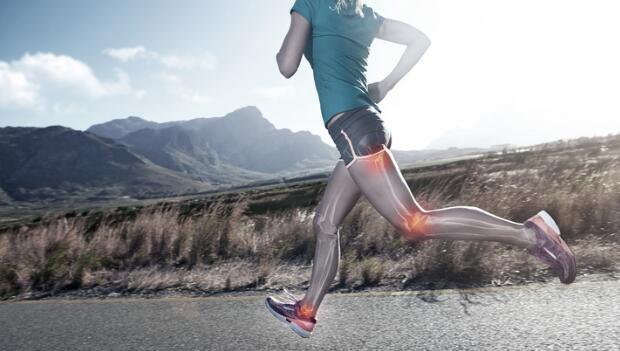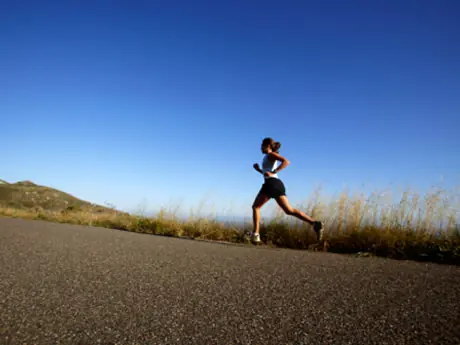
If you've been running long enough, you've most likely had to deal with various aches and pains in your feet, knees, hips or lower back. Plantar fasciitis, Achilles tendinitis, IT-band syndrome, meniscus tears, runner's knee, bursitis of the hip or knee, patellofermoral pain syndrome, chondromalacia patella, lower back pain and piriformis syndrome are only some of many conditions an athlete may develop during the course of his or her running career.
Although there are many factors that can contribute to the development of these conditions, improper biomechanics of the body plays a large and detrimental role in the process. Of the many biomechanical elements involved, foot and ankle function perhaps contribute the most to these aches and pains.
What Is Pronation?
Pronation is the flattening of the arch when the foot lands on the ground. This flattening aids in balance and provides some shock absorption. As the foot flattens slightly, the ankle tilts inward toward the midline of the body, and the muscles of the lower leg help keep the ankle from rolling too far inward.
During a normal gait cycle, the forward movement is a result of the body's mass being displaced, putting the body in a forward-falling position. At this time, the lead foot hits the ground preventing the fall, followed by the rear leg as it swings forward, and the cycle repeats with each step.
Once the foot hits the ground its first function is to absorb and help dissipate the shock of impact. This is followed by pronation of the foot so that it can help accommodate the ground contour. The ankle goes into flexion allowing the knee to move forward, and the body follows. The heel raises, and the foot supinates becoming a rigid lever that aids in the pushing action that eventually ends with the toe-off.
Many other intricate and complex components of motion mechanics take place during this process, but for the purpose of this article, this helps to explain the basics.
What Causes Overpronation?
Folks with flatter feet tend to have highly flexible arches, which are more likely to flatten too much. This is known as overpronation. In this case, the foot provides plenty of its own cushioning but does not retain enough of its own structure, so other parts of the leg, such as the medial tibialis (the "shin splint" muscle) and the knee, try to pick up the job of providing support. They aren't designed for this, and when they are overworked, they send pain signals indicating they can't keep doing the extra labor.
Conversely, people with high arches often have inflexible feet which limit the amount of natural motion the foot undergoes as it lands. These people don't get much natural shock absorption in the foot, and the ground forces will once again travel farther up the leg looking for a place to be absorbed, often in the shins, knees or elsewhere. However, not everyone with flat feet overpronate, and those with high arches may also experience excessive inward ankle rolling due to instability in the muscles of the lower leg.
Just as the structure of the foot can contribute to overpronation, so can poor stride mechanics. Heel striking, leading with your legs, a slow/long stride, or pushing off with the toes can cause excessive motion in the foot.
I've see a lot of runners who've been told that their particular condition is a result of overpronation. Usually, they've had some form of a "postural or gait analysis" done by a coach, trainer or healthcare professional, or at a running store. They are typically fitted with stability shoes, off-the-shelf orthotics or costume-made orthotics; the general intention being to prevent excessive pronation of the foot.
Although this is needed in some cases, it should not be done in each and every case when a runner's foot seems to over pronate. Doing so can and often does result in one symptom going away and another, usually a more complicated one, developing elsewhere.
Foot pronation (turning downward or inward) and supination (turning upward or outward) are normal and needed movements for proper function during the gait cycle.
The following is a brief and simplified reasoning as to why this practice may be flawed if a proper evaluation has not been performed prior to modifying shoes or using orthotics.
In a normal functioning ankle and foot there should be 15- to 20-degrees of ankle dorsiflexion present (leg moving forward on top of the foot; or, same as the foot bending backward toward the leg) as well as 60- to 65-degrees of first toe extension (bending backward).
Foot pronation (turning downward or inward) and supination (turning upward or outward) are normal and needed movements for proper function during the gait cycle. All feet must do this and do it well to minimize the forces that the body has to deal with during walking or running, and also to create the lever that is needed for propulsion.
It is the "excessive pronation" that has been considered a great offender in many of the above referenced conditions. This is when the foot remains in pronation for a longer than normal period of time. This also is what most people try to correct, and often do so improperly.
How many of you have gone to your favorite therapist, doctor or shoe store complaining of some sort of pain? You got a cursory evaluation; were fitted with shoes or orthotics and found that indeed your complaint(s) resolved; but only to find yourself complaining of something else hurting you a few weeks later without having changed anything else in your training.
MORE: A Runner’s Guide to Understanding Pronation
To correctly determine if an overpronation should be corrected using shoes or orthotics, a functional and a structural examination is mandatory. This requires an evaluation of the pelvis, hip, knee, ankle and foot ranges of motion along with at least a lunge and a squat test to examine other elements of motion such as force production, force dissipation, proprioception, stability and balance.
Leg lengths should be examined to rule out inequalities. The pelvis and the spine must be evaluated for proper joint motion and alignment. Last but not least, muscle length and strength ratios may need to be assessed. Without these factors being accurately examined, an improper correction could be made, which will eventually result in other dysfunctions and ensuing pain.
One of the common and frequent reasons for overpronation is a lack of normal ankle range of motion. If the foot/ankle is unable to dorsiflex (bend backward) properly, it will not allow the knee to travel forward enough for the body to move its center of mass over the foot, hence making the forward motion of the body difficult.
In such a case, the foot is forced to pronate excessively and as a result the knee will drift medially (toward midline) and the hip will have to excessively adduct (move toward midline) and internally (turn inward) rotate. This of course continues into the rest of kinetic chain and results in other abnormalities in motion mechanics.
In this particular (and quite common) instance of poor ankle mobility, correction through shoes and orthotics is often asking for trouble. The overpronation in this case is a needed compensation for a lack of mobility elsewhere in the body. Taking this compensatory element away without first addressing and correcting the true underlying cause will inevitably force compensation (frequently accompanied by pain) in another part of the body.
Here is a simple test you can perform to see if you fall under this particular category:
While in a standing position, place your feet shoulder-width apart. Make sure that your feet and toes are pointing forward and not turned outward (away from the midline of the body). See if you can get into a squatting position that places your knees at or below 90 degrees of flexion (bending) without your heels coming off the ground or your feet externally rotating (turning outward).
If you are unable to complete this test, then there is a good chance your foot pronation is due to inflexibility of your ankles and that is what should be corrected, not the pronating foot. Please note that there are other factors, beyond the scope of this article that can be involved here as well.
Before you consider correcting foot pronation, be sure to have a detailed and complete structural and functional evaluation done by a qualified provider. Not doing so may cost you much more than an improperly fitted shoe or useless pair of orthotics. Remember that the real question to that should be answered is not if you over pronate, but why.
 READ THIS NEXT: What Is Gait Analysis and Why DO You Need One?
READ THIS NEXT: What Is Gait Analysis and Why DO You Need One?
How to Correct Pronation
Try introducing the following Chi Running Form Focuses into your workouts:
- Maintain a constant cadence of 170 to 180 strides per minute (spm) no matter what speed you're running.
- Practice landing with your feet below or even slightly behind your center of gravity (hips), not out in front. This is commonly called a midfoot strike.
- Hold your pelvis level with each stride. This works to strengthen all the connective tissue that runs between the arch of your foot and your pelvis. It's a great way to strengthen and stabilize your ankles.
When you consistently apply these focuses to your running, you'll feel stronger, smoother and more relaxed. Eventually, your feet will possess just the right amount of strength, and motion control will no longer be an issue.
Dr. Hamid Sadri is a sport chiropractor from Atlanta, Georgia, with over 24 years of experience. He holds certifications from the American Chiropractic Board of Sports Physicians, National Academy of Sports Medicine, National Strength & Conditioning Association, Graston Technique and Active Release Techniques. He has worked with national and international athletes of all levels and was selected as one of America's Top Chiropractors by the Consumer's Research Council.
Get ACTIVE on the Go


Couch to 5K®
The best way to get new runners off the couch and across the finish line of their first 5K.
Available for iOS | Android







Discuss This Article